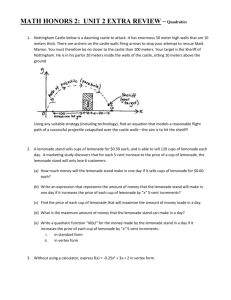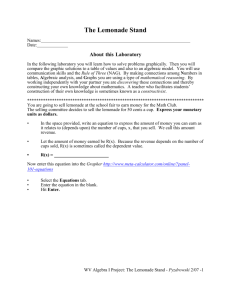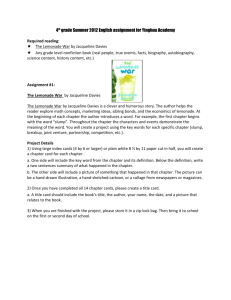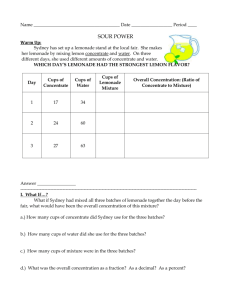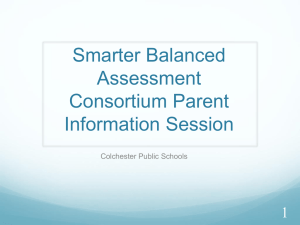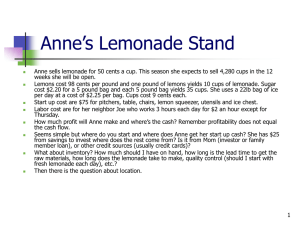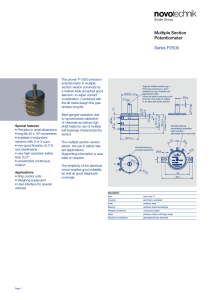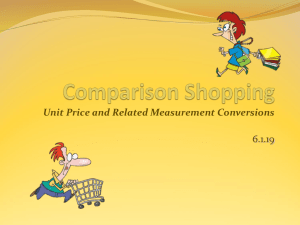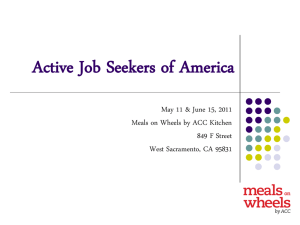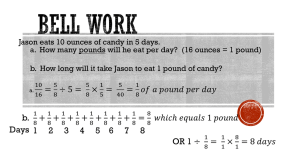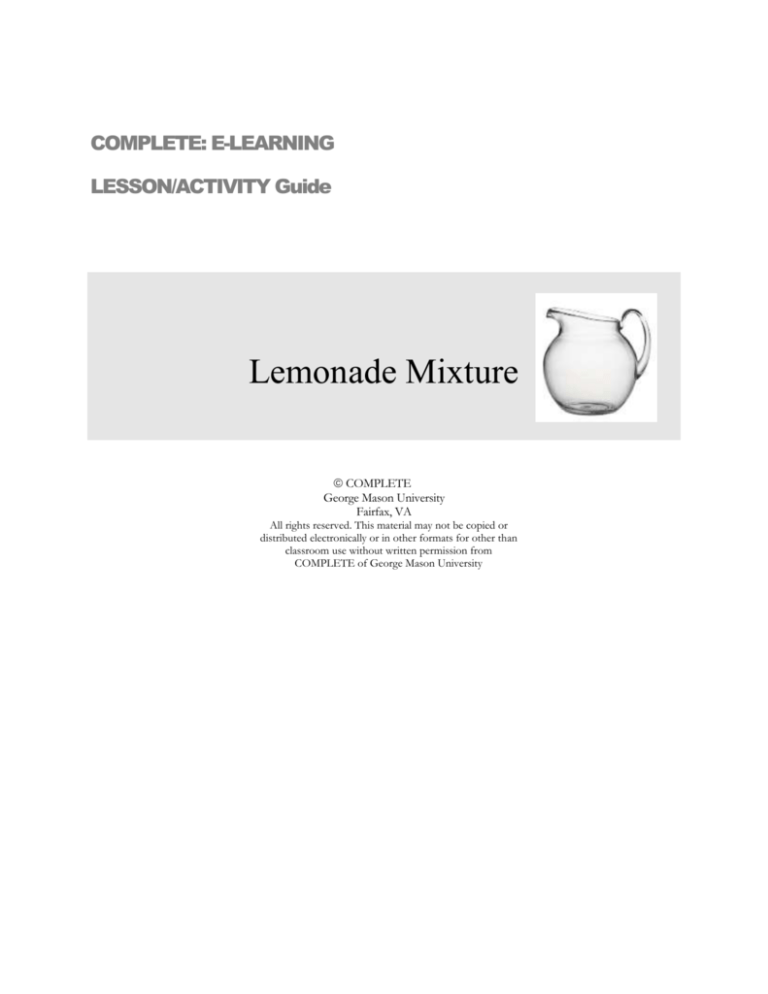
COMPLETE: E-LEARNING
LESSON/ACTIVITY Guide
Lemonade Mixture
COMPLETE
George Mason University
Fairfax, VA
All rights reserved. This material may not be copied or
distributed electronically or in other formats for other than
classroom use without written permission from
COMPLETE of George Mason University
1
ENGAGE
Section
Present the following situation to students:
Joey started a lemonade stand in his neighborhood. Last Saturday he made
one small pitcher of lemonade using 2 cups of lemonade mix and 3 cups of
water. The neighbors loved his lemonade and he quickly sold out. This
Saturday he plans to make more lemonade so that all the neighbors can
enjoy it. He started by mixing 4 cups of lemonade and 4 cups water and then realized that the lemonade
tasted too strong. How much lemonade or water does he need to add so that the lemonade will taste the
way it did last Saturday?
Your job is to figure out multiple solutions to Joey’s problem and multiple representations or strategies for
solving the problem. Remind students of the kinds of representations (concrete/pictorial, numbers &
symbols, tables, graphs, and verbal descriptions) that they may have used in the past.
Introduce students to the Mixtures applet (Illuminations)
http://illuminations.nctm.org/ActivityDetail.aspx?id=154
1) Demonstrate how to use the tool by making Pile A the mixture from last Saturday (2 colored, 3
uncolored circles)
2) Make Pile A the current mixture (4 colored, 4 uncolored circles)
3) Show students how to add, remove, color, and uncolor the circles.
4) Challenge the students to use the applet in paires to find solutions to the problem.
Learning Goals:
Big Ideas:
Create equivalent
Numbers tell how many or how
much.
Make connections between
Any pattern, algebraic expression,
relationship, or equation can be
represented in many ways.
Arranging information in charts
and tables can make patterns easier
to see.
Variables can be used to describe
relationships.
ratios/proportions.
proportions and percentage of
the whole.
Use multiple representations or
strategies to solve and/or prove
a solution.
Make connections between
representations/strategies.
2
1) Students explore the Mixtures applet (Illuminations) to find solutions
to the problem.
2) Questions for students as they are exploring:
2
Section
EXPLORE
What does percentage of colored tell you about the lemonade
mixture?
Does is surprise you that a ratio of 2/3 is 40% of colored? What about 4/4 as 50%?
Can you explain in words what the percentage of colored means and how it is
calculated?
How do you know when the mixtures taste the same?
How many different mixtures can Joey make that will taste the same as his original
mixture?
Can you predict some mixtures that will taste the same, before using the applet?
3) After students have found multiple solutions for the problem, ask them:
How could you use a graph, table, picture, or numbers and symbols, to prove that your
solutions are correct?
4) Have students use other representations to prove their solutions.
3
3
Section
EXPLAIN
Concrete/Pictorial: Area Model
blue = lemonade mix (cups)
white = water (cups)
Numbers & Symbols:
2
Verbal Description:
3
Two cups of lemonade mix and
three cups of water is 40%
lemonade mix because there are
two cups of lemonade mix for
five cups of total mixture. So
2/5 equals 40%. Four cups of
lemonade mix and four cups of
water is 4 cups of lemonade
mix for 8 cups of total
mixture. So 4/8 equals 50%.
=
?
(3 x 4) ÷ 2 = 6
2
3
=
𝐿
𝑤
2w=3L
w=
𝐿=
Graph:
3𝐿
2
2𝑤
3
Table:
Lemonade
Mix (cups)
Water
(cups)
2
3
% of
Lemonade
Mix
40%
4
4
50%
4
5
44%
4
6
40%
5
6
45.45%
2
5
7
41.67%
0
5
8
38.46%
6
8
42.86%
6
9
40%
14
12
Water (cups)
4
8, 12
10
6, 9
8
6
4, 6
4
2, 3
0
2
4
6
8
10
Lemonade Mix (cups)
4
Connections between representations:
4
Section
ELABORATE
The graph is a visual representation of the table data. The graph
shows why there is no whole number proportion for 3, 5, 7, 9, 11
parts of lemonade mix.
You can use an equation to prove the process of solving proportions.
The verbal description can explain why the ratio 2/3 is 66.6%, but is instead 2/5 = 40%. This
is because percentage is a ratio of the whole. If there are 2 cups of lemonade mix and 3 cups or
water, then there is ratio of 2 cups of lemonade to 5 total cups of mixture.
Connections to other curriculum:
Chemistry – proportions are used in balancing chemical equations
Probability – proportions and percentages are used in calculating theoretical probability.
Relevance in the real world:
Cooking – using proportions to make larger or smaller amounts of recipes.
Machines – mixing oil and gas in proportion for use in the engines of machines.
Home Improvement – mixing paint, concrete, etc. in proportion.
5
5
Section
EVALUATE
Explain how your students demonstrate their new understanding and skills.
What is the learning goal and learning product for this lesson?
INCLUDE STUDENT WORK!
6
COMPLETE GRADES k-8
E-LEARNING LIBRARY
INTERACTING WITH MATHEMATICS
COMPLETE
George Mason University
Fairfax, VA
All rights reserved. This material may not be copied or
distributed electronically or in other formats for other than
classroom use without written permission from
COMPLETE of George Mason University
7

